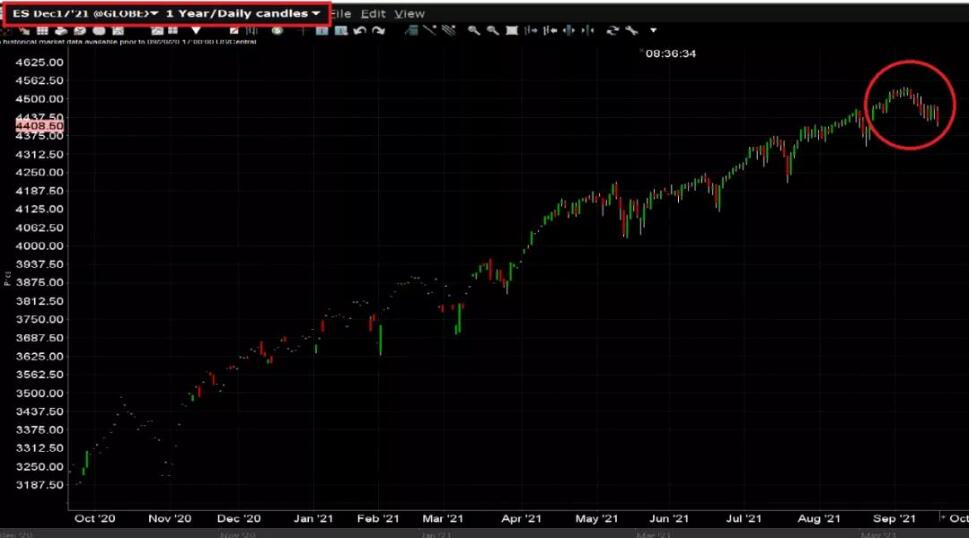Before the commission of the US government, the US stock market was "extremely high."

October is the stock market curse?
There are various rumors on Wall Street, one of which is that the stock market in October is the worst. I personally agree with this statement, and the problems that may arise in October this year seem to be more serious than in the past.
According to U.S. law, September 30 is the last day of the U.S. government’s fiscal year, and October 1 is the first day of the U.S. government’s new fiscal year. However, how the highest debt of the US government, which has been continuously moving upwards since July this year, will continue to move upwards in the new year, which will face enormous challenges.
You can see that concerns about this situation have now been reflected in the U.S. stock market. Under such an environment, how should we trade the U.S. stock market?
How to deploy risk in the U.S. stock market
The current U.S. stock market is at a historical high, but due to the uncertainty about the future, high volatility should be the most likely trend of U.S. stocks in the near future. Under this trend, making full use of short-term options to build a long straddle arbitrage (BuyStraddle) not only protects the possible downside risks, but at the same time does not lose the upside trading opportunities in the market. This strategy may be a relatively safe strategy.
The U.S. stock index derivatives market may be the most mature stock index derivatives market in the world. Just taking the CME Group stock index derivatives market as an example, there are dozens of products for everyone to choose from.
Everyone is familiar with CME Group’s E-mini S&P Index futures and E-mini S&P’s standard options. Perhaps everyone is not familiar with CME Group’s simultaneous trading of three E-mini S&P indexes with different expiry dates. Weekly Options. Now I will give you a brief introduction to these three weekly E-mini S&P index options with different expiration dates.
First, unlike E-mini S&P index standard options, E-mini S&P index standard options are American options, which means that the holder of the option can exercise the option at any time. E-mini S&P index short-term weekly options are European-style options, which means that the holders of weekly options can only exercise their options on this day of expiration.
Second, the expiration dates of these three short-term weekly options are 3:00 PM Chicago time every Monday, Wednesday, and Friday.
Third, these three short-term weekly options are spot transfers, and the transfer product is the current month's E-mini S&P index futures (ES).
The trading codes of the E-mini S&P index short-term weekly options that expire every Monday are: E1A, E2A, E3A, E4A. Represents transactions with different maturities on the four Mondays of each month.
The trading codes of the E-mini S&P index short-term weekly options expiring every Wednesday are: E1C, E2C, E3C, E4C. Represents transactions with different maturities on the four Wednesdays of each month.
The trading codes of E-mini S&P index short-term weekly options that expire every Friday are: EW1, EW2, EW3, EW4. Represents transactions with different maturities on the four Fridays of each month.
In this way, in the US stock index market, there has been a continuous ultra-short-term (only two days) E-mini S&P index option.
What are its benefits? Its greatest advantage is that the buyer of the option can use the minimum cost to obtain the maximum profit.
In order to meet the needs of global small investors for indexed investment in the U.S. stock market, in May 2019, CME Group launched four micro E-mini index futures specifically for small investors around the world, including the micro E-mini S&P index Futures (MES), micro E-mini Nasdaq stock index futures (MNQ), micro E-mini Dow Jones stock index futures (MYM) and micro E-mini Russell 2000 stock index futures (M2K).
After more than two years of successful trading, the trading volume of micro E-mini index futures in Asian time has accounted for more than 10% of global trading volume. In August last year, CME Group successfully launched micro E-mini S&P index (MES) options and micro E-mini Nasdaq index (MNQ) options. This is another good news for small investors to enter the US stock index derivatives market.
Stock index quarterly shift analysis tool
September is the month in which the US stock index futures market shifts positions. The transaction of futures shifts is actually a calendar spread. Due to the liquidity in the futures markets of two different months, this spread may not be a reasonable spread. How can I figure out whether the futures shift is reasonable? It can be calculated using a special tool on the CME Group website. Personally translate this free tool into "Equity Quarterly Roll Analyzer Tool" (Volume Weighted Average Price", which is the spread of the shift, which represents the real implicit financing Expenses (IMP.FIN). The larger the futures discount, the smaller the actual financing cost. You can compare the financing costs of the small S&P (ES) and the Nasdaq index (NQ).
Although the current U.S. stock market has a "feeling of being overwhelmingly high", because the U.S. is the world's largest economy, it is also full of very active economic potential. Compared with Japanese companies and German companies, American companies pay more attention to the interests of shareholders. Therefore, based on the above reasons, the possibility that American stocks will continue to rise is still very high.



